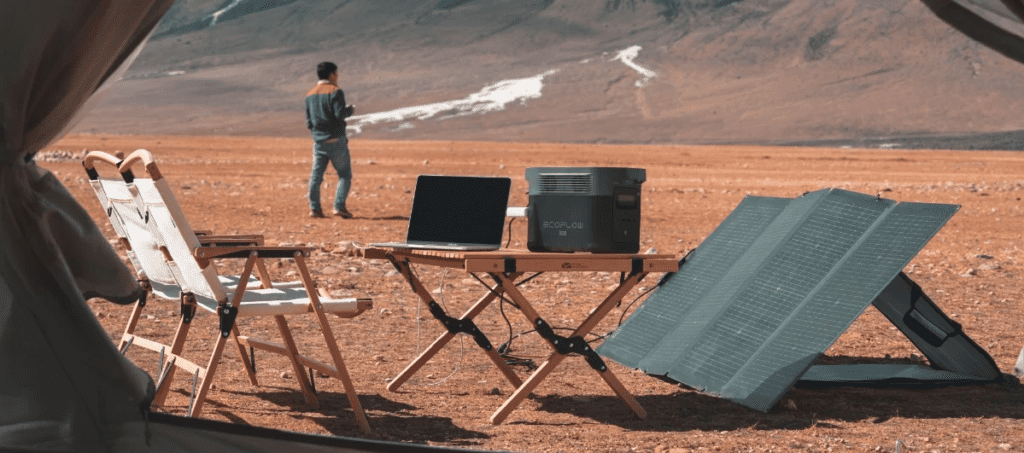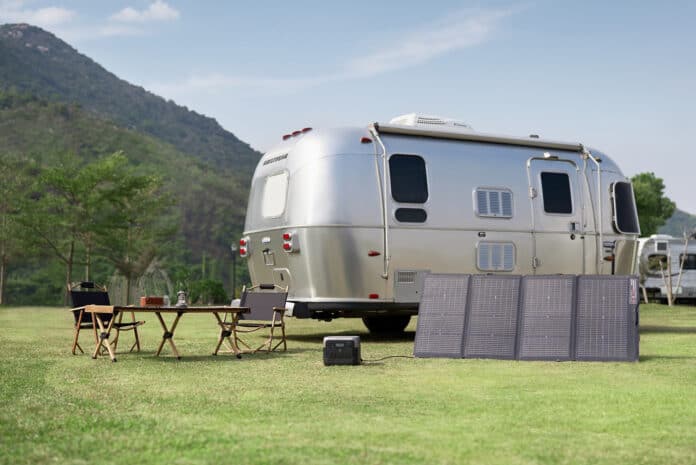Solar panels capture the sun’s energy which is then converted into usable electricity to power appliances, electronics, and even entire homes. How much power a single solar panel can capture depends on the rated wattage, the size, and the structure of the panel — as well as numerous environmental factors.
Depending on your desired setup, portable solar panels may be better for your needs than a fixed installation — they might even produce more electricity than a rooftop solar array if you have roof obstructions or other limiting factors.
Here, we look at how to calculate solar panel output, the different applications of portable solar panels, and the factors affecting their efficiency.
How Much Power Can a Portable Solar Panel Produce?
A portable solar panel carries a rating for the maximum power it can produce hourly. If you buy a 100-watt panel, it can convert sunlight into 100 watts of electricity for every hour it has exposure to peak sunlight.
The rated power of portable solar panels varies between manufacturers and models. EcoFlow Portable Solar Panels, for example, range between 110 watts and 400 watts, depending on which model you purchase. Under ideal conditions, each panel can produce its rated power in electricity every hour it receives direct sunlight.
You can calculate power output in ideal conditions using this simple formula:
PV panel wattage x peak sun hours = energy output in watt-hours
However, a few factors impact the actual production.
For one, the power you capture using solar panels can’t just float through space. You need to connect your solar panels to a battery and balance of system that includes an inverter and charge controller to convert, manage and store the power that solar panels produce.
A portable power station like the EcoFlow DELTA Pro supports solar charging from rigid, flexible, and portable solar panels. It is sufficiently expandable to convert and store enough energy to backup an entire home.
The combined power output you receive from your solar panels— and your portable power station’s maximum solar charging capacity — determines how quickly and efficiently you can recharge off-grid or outside the home.
Compatibility is also important to consider. If you attempt to connect 400W panels to the EcoFlow RIVER 2, which has a maximum solar charging input of 110W, you’ll risk causing an electrical overload.
If you’re using a portable solar panel with a compatible power station, the battery will operate when charged or charging and store any additional power output from the panels to keep in reserve for use when you’re ready.
The actual output you receive from your portable solar panels depends on the angle they face towards the sun, any obstructions, and other factors that might impede the sun rays from reaching the panels. During periods when the sun doesn’t shine directly on the panels, they will produce less power.
However, even on overcast or rainy days, portable solar panels can harvest ambient light and convert it into electricity.

Understanding the Power Output of Portable Solar Panels
Manufacturers list the power rating of solar panels in watts. But the power wattage reflects the voltage produced by the panel times the current at which the electrons move, measured in amperes (or amps for short.) The power rating of a solar panel expresses the combination of volts and amps that determine the total electricity produced.
Volts
Volts measure the pressure or speed of electrons moving through a system. Photovoltaic cells capture sunlight and release electrons. The force with which they do that creates the voltage within the electric system.
The type of cells a portable solar panel has, and the more efficiently those cells work, the higher the voltage created. The pressure is half of the equation for the amount of energy a single panel can produce.
Amperes
The other half of the equation is current. Amperage, or amps, measure the rate at which the electrons flow through the circuit.
A solar panel produces volts and allows them to move at different rates, resulting in different amounts of power created. The higher the current, all else equal, the higher the rated power.
Watts and Kilowatts
The wattage that a portable solar panel generates is the product of the voltage and the amps.
Voltage (V) x Amperage (A) = Wattage (W)
So if a solar panel produces 80 volts of electricity, and the amperage of that panel is five, it produces 400W for every hour of direct sunlight.
Often, manufacturers list storage capacity and other specs in kilowatts. Since a kilowatt is simply 1000 watts, a 400W portable solar panel can produce 0.4 kW for every hour of direct sunlight.
Watt-Hours and Kilowatt-Hours
The sun doesn’t shine on a portable solar panel for 24 hours a day. So if a 400-watt panel receives five hours of direct sunlight daily, it can produce 2,000 watt-hours (Wh), or 2kWh, per day.
When Is It Suitable to Use a Portable Solar Panel?
The measurement of kWh doesn’t mean much until you look at the energy consumption needs of the devices and appliances you want to power.
For example, if a particular device requires 100 watts per hour to run, a 400-watt solar panel that generates 2 kWh per day could power that device for 20 hours (2000 kWh / 100W = 20 hours). Knowing the total output of your portable solar panels helps us understand what we can power with them.
Remember, solar panels don’t simply connect to your appliances. A portable solar panel connects to a power station or other balance of system, allowing you to charge up using solar power and connect your devices or appliances to the power station.
The portable power station’s output, storage, and solar charging capacity also determine what appliances you can run.
Camping and RV Trips
RV and camping trips can be the perfect escape from modern life. You load up an RV or backpack, unplug, and unwind from the daily grind.
If you don’t want to unplug entirely, a portable solar panel and a small portable power station like the EcoFlow RIVER 2 can help power small appliances and devices on the trip. It’s compact, lightweight at 7.7 lbs (3.5 kg), and easily fits in your backpack.
Or you can affix rigid and flexible solar panels to your RV’s roof and other exterior surfaces to charge your solar batteries while driving. EcoFlow’s Power Kits are designed expressly for permanent RV installations.
Off-Grid Living
Similarly, portable solar panels can provide an excellent option for running electronic appliances in a cabin or tiny home off-grid.
Where a larger house might be better equipped with an extensive array of rigid solar panels in a fixed installation, portable solar panels can help you get the electricity you need wherever you go off-grid, whether temporary or permanent.
Things That Affect Portable Solar Panel Production
How you set up and use your portable solar panel will impact the amount of electricity your panels generate. Lab conditions seldom occur in real-life, so knowing how to get the most out of your portable solar panels helps ensure maximum return on your investment in off-grid power.
Panel Type
The photovoltaic construction of your solar panel significantly impacts its efficiency. The two most common types of solar panels are monocrystalline and polycrystalline.
Monocrystalline photovoltaic panels consist of a single silicon cell. The design offers more conversion efficiency, allowing the solar panel to convert more solar energy into electricity using a smaller surface area.
Polycrystalline photovoltaics consist of multiple silicon cells. The design is not as efficient at maximizing electricity output but is more affordable.
Amount of Direct Sunlight
The rated power of a solar panel is based on receiving direct sunlight. If you have a 400-watt panel, it’s designed to produce 400 watts for every hour of peak sunlight. The hours of peak sunlight vary by location and season, so the total output from each solar panel will differ based on these and other factors like temperature.
The angle of the solar panel also affects how much electricity it can generate. A general rule of thumb is to position the panel true south at an angle between 30 and 45 degrees.
One significant advantage of portable solar panels is that they’re much easier to reposition — even over the course of a single day — than rigid and flexible solar panel installations.
If a solar panel is set up at the wrong angle, it will still receive sunlight but not the maximum amount available. The result will be a lower overall output from your solar panel array. Determining your portable solar panels’ optimal orientation and tilt angle can increase efficiency.
Temperature
When calculating solar panel ratings, manufacturers typically set them up in lab conditions with a temperature of 77°F (25°C). If the real-world temperature is higher or lower, the output from the portable solar panel may be reduced.
The effect of temperature will generally be small, but it can impact the total energy you receive from the panel.
Obstructions
Anything that impedes sunlight from hitting your portable solar panel will also reduce its output. An obstruction can be anything from trees that cast shade to cloud cover.
Again, this will not eliminate your output entirely; solar panels still work on cloudy days. But anything that reduces the amount of sunlight directly hitting solar panels will reduce the electricity production you can expect.
Conclusion
A portable solar panel can provide an indispensable method of generating clean, renewable energy when you’re off the grid or on the move. Understanding the power rating and how it impacts the amount of electricity you can generate will help you get the most out of your investment in portable solar energy.
Rated power output from solar panels isn’t everything — you need a compatible portable power station to convert and store energy from your portable solar panels.
For a truly portable setup, consider the EcoFlow RIVER 2. It’s powerful enough to meet essential electricity needs on a camping trip and light enough to carry comfortably to remote locations.
Purchasing the right solution for your portable solar energy needs begins with knowing how much electricity you require and for how long. Then you can pick the solar panels that are best suited to your off-grid needs.
